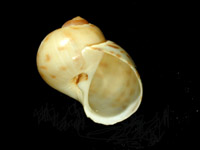|
|
The
sand snails are a relatively small family with about 200 living species,
cosmopolitan in distribution. They are common inhabitants of intertidal
sand and mud flats, where they plough through the sand or mud, on or
just below the surface, leaving a broad trail behind them. They are
carnivorous, feeding mainly on bivalves; they drill a small hole by
radular action assisted by acid secretions and suck the tissues out of
the prey.
The
family is well represented in NSW with 25 species recorded. Five large
species occur in estuaries and on exposed beach flats around Sydney,
with Conuber conicum and Conuber sordidus being the most
common. A few representatives of the tropical Indo-West Pacific fauna
intrude into the north of the state, occasionally reaching Sydney. The
third component of the local fauna is a group of deep-water species,
some of which are common but rarely seen in collections; they are mainly
less than a centimetre in size, and have eastern or southern Australian
distributions.
Family
References:
-
Cernohorsky,
W.O. 1971. The family Naticidae in the Fiji Is. Records of the Auckland
Institute & Museum 8:169-208.
-
Kilburn,
R.N. 1976. A revision of the Naticidae of southern Africa and Mocambique
(Mollusca). Annals of the Natal Museum 22(3):829-884.
-
Kabat,
Alan R. 1991. The classification of the Naticidae (Mollusca: Gastropoda):
review and analysis of the supraspecific taxa. Bulletin of the Museum of
Comparative Zoology 152(7): 417-449.
Coverage:
In
addition to those illustrated, the following species occur in NSW.
Tropical
Indo-West Pacific species that reach into NSW, but are of uncommon to
rare occurrence here:
-
Natica
alapapilionis (Roding, 1798). Indo-West Pacific to Woolgoolga,
NSW.
-
Natica
fasciata (Roding, 1798). Indo-West Pacific, to Solitary Islands,
NSW.
-
Natica
onca Roding, 1798. Indo-West Pacific to Woolgoolga, NSW.
-
Natica
pseustes Watson, 1881. Indo-West Pacific to Sydney, NSW.
-
Mammilla
melanostomus (Gmelin, 1791). Indo-West Pacific to Sydney, NSW.0
-
Mammilla
fibrosa (Eydoux & Souleyet, 1852). Indo-West Pacific to
Broulee, NSW.
One
species is known only from the holotype , probably subfossil, dredged
from Sydney Harbour:
Identification
Notes:
Two
useful characters for the identification of species in this family are
the columellar callus and the operculum. The shape of the callus, and
the extent to which it covers the umbilicus, assist in separating
species, although there is some ontogenetic variation of this character
within a given species. The operculum may be calcareous or corneous, a
characteristic use for definition of the genera.
|
